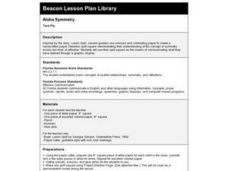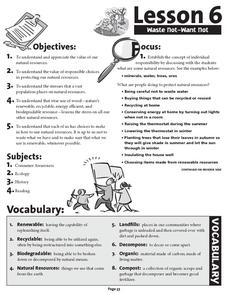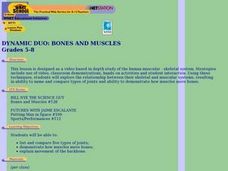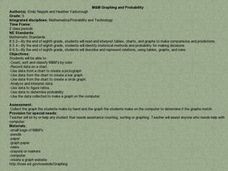Curated OER
Simply Symmetry
Learners are introduced to the concept of symmetry by examining different shapes and folding them into equal halves. They work in small groups focusing on finding the lines of symmetry of one specific shape. A symmetry booklet is made by...
Curated OER
Measuring Up on the Mayflower
Second graders use a meter tape to compare the length of the Mayflower to a basketball court and make homemade butter for crackers. Afterward, all students sit inside the makeshift Mayflower's dimensions and enjoy their Pilgrim butter.
Curated OER
Aloha Symmetry
Learners create handcrafted paper Hawaiian quilt squares. They do this to show the concept of symmetry across two lines of reflection.
Curated OER
Crime Watch
Students analyze the recent rise of homicides in some American cities, create and share posters, and write reflective essays in the form of letters to community leaders.
Curated OER
Backyard Critters
Young scholars explore the characteristics of invertebrates in their backyards. They observe, describe, and classify specimens. They conclude with a "snail race."
Curated OER
Rock Hounds
Students receive a basis for understanding the three main classifications of rock: igneous, sedimentary and metamorphic. They engage in a hands-on activity designed to give them an appreciation for rocks and minerals.
Curated OER
Waste Not Want Not
Students are introduced to the need to save natural resources. Through inquiry, hands-on activities, and problem solving, students increase their understanding of solid waste materials and the need to reduce, recycle, and reuse.
Curated OER
Dynamic Duo: Bones and Muscles
Learners explore the relationship between their skeletal and muscular systems, resulting in ability to name and compare types of joints and ability to demonstrate how muscles move bones.
Curated OER
I Am Golden
Students become familiar with patterns, the Fibonacci Sequence, and the Golden Ratio. They see how many places these occur. They have practical applications for using the calculator and making charts to extend patterns.
Curated OER
Reaching Into Your Genes
Students interact with a video to explore the basis for the science of chromosomes. They perform a chromosomal analysis called a karyotype and explore how seemingly minute errors in chromosomes can lead to devastating illnesses.
Curated OER
THE PHYSICS OF MOVING THINGS (AND NOT A MOMENTUM TOO SOON!)
Students list three examples of momentum found in their local environment; describe the importance of mass and velocity on momentum; and determine what is necessary to produce the greatest amount of momentum within a particular system.
Curated OER
Would You Believe Your Eyes?
Students study the parts and functions of the human eye. They create dodecagons which are twelve-sided figures with twelve equal angles and share these with the class so that each student can begin to see how many different illusions can...
Curated OER
As Good As Gold
Students find examples of the Golden Ratio on the human body through measurement. Additionally, students learn about the use of the Golden Ratio and the Golden Rectangle in art and architecture. A very interesting lesson plan for the...
Curated OER
What would you do if faced with this problem?
Learners determine how and why an individual from each of four disciplines - Buddhism, Taoism, Confucianism, and Legalism - might respond to the same problem.
Curated OER
Miami Metrozoo & Mathematics
Twelfth graders use Algebra and Geometry to solve a real life problem at the Zoo.
Curated OER
M&M Graphing and Probability
Students sort, classify, and graph M & M's. They create pictographs and bar graphs with the colors and numbers in each bag of M & M's. They calculate the ratio and probability based on class results.
Curated OER
Egg Fun
Students investigate the characteristics of eggs by playing and experimenting with them.
Curated OER
Roadkill Museum
Learners use roadside kill to use taxidermy skills, become comfortable working with animals and dissecting.
Curated OER
Conversions: Metrics Made Easy
Students, in groups, measure and record each other's height. They identify measurement conversion methods and use online resources to convert measured heights to multiple systems.
Curated OER
Where's the Point?: Two-Point Perspective in Texas Bird's-Eye Views
Students investigate how the Texas bird's-eye-view artists used two-point perspective to create their aerial views and consider the directions from which the artists oriented their views. They produce two drawings in tow-point perspective.
Curated OER
Sticky Note Math
Sixth graders examine mathematical problems that deal with he division of fractions. Sticky notes are used to model the process.
Curated OER
Move It, Sir Isaac!
Third graders analyze the work of Sir Isaac Newton as they investigate the laws of motion and force. Inertia is observed through a lump of clay.
Curated OER
Royal Treatment
Students analyze the Nepalese King's response to pro-democracy demonstrations, and examine existing monarchies around the world. They conduct research, read an article, and present information on various modern-day monarchies.
Curated OER
In a Giants Garden
Students explore the effect of the earths rotation and its relationship to the suns position and the effect that the longer and shorter amount of daylight has on a pumpkin plant which they have planted.
Other popular searches
- Measuring With a Ruler
- Metric System Ruler
- Kings and Rulers
- Standard Measurement Rulers
- Metric Ruler
- Using a Ruler
- Reading a Ruler
- Measuring Using a Ruler
- Ruler Measurement
- Paper Rulers
- Measure With Inch Ruler
- Measurement With a Ruler

























